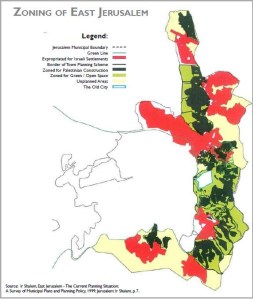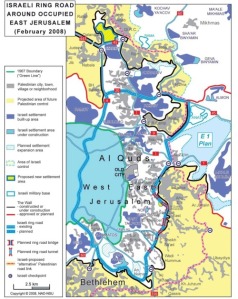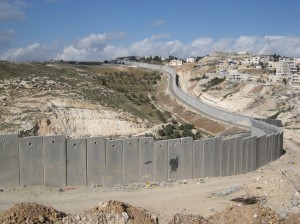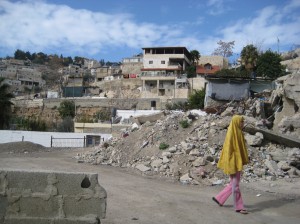Architectural planning for a different future
 Saturday, July 17, 2010 at 12:31AM
Saturday, July 17, 2010 at 12:31AM Sarah Irving, The Electronic Intifada, 15 July 2010
 |
| Ush Grab, occupied West Bank. (Decolonizing Architecture) |
"If you live under a colonial regime, the first thing you are prevented from doing is thinking about a future," proclaims Sandi Hilal. "This is the first thing that the occupation imposes on you. And to propose in Palestine right now a future where you can plan, imagine, is something which is very important."
Hilal is one of the founding trio at Decolonizing Architecture, a project which, according to its website, "uses architecture to articulate the spatial dimension of a process of decolonization." In practical terms, according to director Alessandro Petti, the project brings together a "collective of artists, architects and scholars" which mixes residencies and studio work. Some of the collective's work is an artistic, gallery-based contemplation of what a future, post-colonization Palestinian landscape might mean. An example is its July/August 2010 participation in The Spacemakers, an UK exhibition which, according to its website, "explores artistic perspectives on the immediate challenges of creating a home, in some of today's most diverse and harried urban landscapes."
Lest this look like another detached artistic endeavor with little connection to the realities of occupation, the collective is firmly rooted in West Bank life. Sandi Hilal and Alessandro Petti both live in the Palestinian town of Beit Sahour located near Bethlehem in the occupied West Bank. Hilal works with refugee camp improvement programs sponsored by the UN agency for Palestinian refugees (UNRWA). One of Decolonizing Architecture's most active roles has been in the struggle for the West Bank hilltop of Ush Ghrab, where Israeli settlers have been trying to take over a decommissioned Israeli military base and encroach on surrounding Palestinian farmland.
"In 2007," Petti explains, "after a decade of engaging in spatial analysis and theory and taking the conflict over Palestine as our main case study," he, Hilal and Eyal Weizman, their London-based colleague, "tried to shift the mode of our engagement and establish an architectural practice based around a studio residency in Bethlehem." The group wanted, Petti says, to be more "oppositional" but also to create "propositions" and ways for themselves and for ordinary people to think about a future beyond the current political impasse and its impact on Palestinian housing, travel, health and education.
Petti explains: "We are dealing with a complex set of architectural problems centered around one of the most important dilemmas around political practice -- how to act propositionally and critically [in] an environment where the political power is so dramatically distorted in favor of the colonizer?" In a practical sense, the group engages with issues of whether useful intervention is possible without becoming complicit with the Israeli colonial regime.
For the thinkers at Decolonizing Architecture, the term "decolonization" is key, representing a way to think about the concrete effects on the ground of the occupation, and of solutions to it. The current focuses for negotiations and discussions, the one, two and three-state solutions are, says Petti, "trapped in a kind of top-down perspective, each with its own self-referential logic." So the collective's thought goes beyond replacing one set of power structures, those of occupation, with a second set, those of a putative Palestinian state.
In practice, this means taking the architecture of occupation and, rather than simply using it for the same purpose under a different power, finding new ways for it to serve everyday uses. As Eyal Weizman points out, the destruction of the Gaza settlements during the Israeli withdrawal of 2005 created toxic waste which has poisoned the Strip's already sparse water supplies.
"In Palestine we find that there are basically three different approaches dealing with evacuated colonial structures: destruction, re-occupation and subversion," says Petti. "The impulse of destruction seeks to turn time backwards, reverse the development into virgin nature, the time at which a set of new beginnings can be articulated. Another strong contention has been to re-occupy the colonial structure and re-use it in a similar way to that used under the colonial regime. But such repossession tends to replicate the colonial power relations in space."
Decolonizing Architecture proposes another option: subversion. In 2007, the collective's first project sought to rethink the Israeli settlement of Psagot, near the Palestinian town of al-Bireh in the occupied West Bank. Their vision of a post-occupation, reconstituted Psagot did not simply transfer Palestinian families into settler homes, retaining the spatial separation, creating what Petti calls "a gated community for the Palestinian elite." Instead, the group found a 1950s Palestinian map of the hill now occupied by Psagot and superimposed it on plans of the settlement, using it to suggest ways in which sharply-defined modern structures could be blurred back into the surrounding landscape, introducing public spaces within the settlement, reintroducing relationships between Psagot and the neighboring homes of al-Bireh, and breaking down the rigid divisions within the Israeli settlement, with their separating walls between homes and between public and private spaces.
"But then in 2008 we actually had the opportunity to engage in a real case of decolonization," says Petti. After the military base at Ush Ghrab was evacuated by the Israeli army in 2006 a debate began over the use of the land, with proposals including a hospital, public park and children's play area. The side of the hill was rapidly opened up into public gardens, but after settlers tried to reclaim the summit, the area became the scene of regular demonstrations between the Israeli extremists who form the nucleus of most settlements, and local Palestinian residents and their international supporters.
Decolonizing Architecture's role shifted from drawing up the requested architectural plans for the Beit Sahour municipality and implementing solutions. This included painting over settler graffiti on the hilltop buildings as well as drawing up documentation for the legal struggle to keep Ush Ghrab out of settler hands. It also involved working with the Palestine Wildlife Society to think of ways in which Israeli military buildings can be "subverted" into breeding sites for local bird species.
"This project," says Petti, "deals with a fundamental question of how Israeli military bases could be reused, recycled or reorientated by Palestinians after the moment that the military power discharges it."
The impact of Decolonizing Architecture's role at Ush Ghrab and of its explorations of the possibilities for sites such as Psagot have, Petti claims, started to shift thinking amongst local planners and municipalities in the occupied West Bank.
"Before we started, we don't believe there was any thinking going on about Area C," he says. Under the Oslo accords signed by Israel and the Palestine Liberation Organization in the mid-1990s, "Area C" is under full Israeli control and represents the majority of the land in the occupied West Bank.
Envisioning what might be done with evacuated settlements might seem pie-in-the-sky, but Petti believes that thinking beyond the current political realities is vital. "The municipalities weren't preventing research on this," he says, "but it was a kind of self-censorship. It is not our solutions which are important, but allowing people to say, 'I have to think and write about this because this is our land, these are our houses.' Some of our students had a good point, that Palestinian workers built these houses, so it makes no sense to destroy them, it makes more sense to use them. Now, if you go to al-Bireh's municipality, their planning maps include Psagot."
"I have to admit that when we began this project, the three of us were not absolutely aware of the potential of the process itself, how important it is to propose a process," says Sandi Hilal. "Until now, the Israelis have been the ones who are planning and the Palestinians are the ones who are reacting." Decolonizing Architecture, she insists, "begins from the end," taking the reality of the occupied West Bank and wider Palestinian life and taking back for her fellow Palestinians "the right to plan their own future."
She also vehemently defends this position. Rather than returning to the analytical approach which all three members followed as students and scholars, Decolonizing Architecture deals with the "common ground" of daily life, exploring practical ways to re-appropriate Israel's architectural "facts on the ground." "Because otherwise we will be explaining and re-explaining the same thing," Hilal says. Of a 2011 architectural residency which the group is currently recruiting for, she declares: "if you come as a scholar and see [Israel's] wall or settlements for the first time, I can understand your reactions. But if you think that you have a tabula rasa and that you will be the first one to give a perspective to the wall, you will absolutely not be permitted to think like this."
As Decolonizing Architecture develops, says Petti, it engages with new aspects of the decolonization process. Working with the inhabitants of Dheisheh refugee camp near Bethlehem, the collective is trying to think with second, third and fourth generation Palestinian refugees about how they can substantively improve their living conditions within the camp, without giving up their claims to the land they were forced off in 1948.
As well as looking at this issue through the experiences of refugees living in the occupied West Bank, they emphasize the role of Palestinians living within Israel and the "returns" they exercise on a daily basis. Working with the Israeli group Zochrot, they have created a "Book of Returns" which uses interviews and drawings to create "a collection of ideas for an effective return of Palestinian refugees" and inform debate about what return might actually mean in a practical sense -- both for Palestinians coming to their ancestral homes, and for the West Bank and in the refugee camps in Syria, Lebanon and Jordan.
"There is the main Israeli narrative about the right of return, which is the invasion of the barbarians, but Palestinians have a similar kind of image, that they will come back the day after this right is recognized," says Petti. "We were thinking about the contemporary practice around this right and images of how significant camps are in many Arab cities, and how political space needs to be created in the Middle East in order to allow people to not have to choose between a life in Beirut or a life in Palestine, but how it is possible to combine both of them."
Sarah Irving (www.sarahirving.net," is a freelance writer. She worked with the International Solidarity Movement in the occupied West Bank in 2001-02 and with Olive Co-op, promoting fair trade Palestinian products and solidarity visits, in 2004-06. She now writes full-time on a range of issues, including Palestine. Her first book, Gaza: Beneath the Bombs, co-authored with Sharyn Lock, was published in January 2010.
The Spacemakers will be featured at the Edinburgh Art Festival 30 July-24 August 2010. For more information visit The Delfina Foundation.
Related Links
-----------------------------------------------------------------------------------------------------------------------
 APJP | Comments Off |
APJP | Comments Off | 





